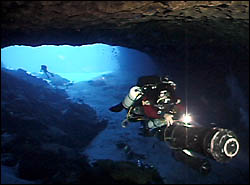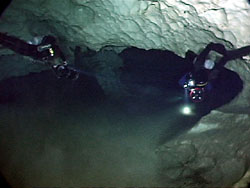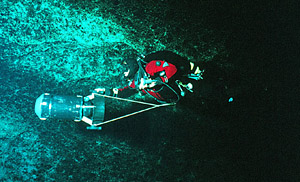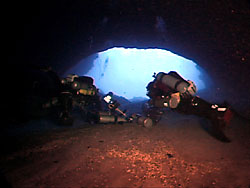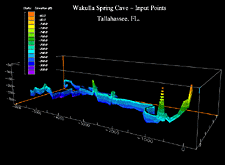Unraveling the Mysteries of the Maze
Unraveling the Mysteries of the Maze
|
By Michael Wisenbaker, WKPP Archeaologist Entrenched in the sandhills of the Apalachicola National Forest, Big Dismal Sink drops some 75 feet before breaching the sparkling waters of the Floridan aquifer. The last 40 feet of the sink cut through sheer limestone walls mantled by a resplendent array of liverworts and ferns. Many years ago my school pals and I would converge at this cenote where we found relief from north Florida's sweltering summer sun by leaping from the sink's rim into its chilled 69 degree waters. We did not know nor care that this backwoods swimming hole would later prove to be a gateway into the longest underwater cave (17.5 miles so far) in the United States.
This marvelous maze and nearby conduits lie in a region referred to as the Woodville Karst Plain, which stretches more than 450 square miles from Tallahassee's south side into the Gulf of Mexico. Limestone, ranging in age from 38 to 23 million years old, found here usually rests anywhere from the surface to just 20 feet below ground. The sugar-white sands overlying the limestone were deposited as terraces and dunes during higher sea level stands of the Pleistocene. Springs, sinkholes, lost rivers and karst windows (depressions in the land where roofs of underground streams have collapsed and exposed sections of caves) afford the only surface evidence of hidden caves and voids that riddle the karst plain's basement. Etched by the gradual corrosive effects of acidic water (primarily derived from rain passing through the atmosphere and forming carbonic acid) that dissolve more soluble portions of the bedrock, the caves themselves formed during the past two million years as Ice Age ocean levels fluctuated with climatic oscillations.
Florida has been acclaimed for its springs ever since apocryphal tales of Spanish explorer Ponce de Leon's search for the "Fountain of Youth." Samuel Taylor Coleridge found inspiration for Kubla Kahn's sacred river Alph and "caverns measureless to man" not in Marco Polo's accounts of China, as one might suppose, but in William Bartram's descriptions of springs in Florida. The Woodville Karst Plain holds seven of the state's 27 first magnitude (those with a minimum flow of 64.7 million gallons of water per day) "springs." Wakulla Springs is by far the most famous such feature in the karst plain, although it pales in comparison to Spring Creek Springs in terms of water discharge. While Wakulla averages a mere 252 million gallons of water per day, Spring Creek Springs, a submarine spring in Oyster Bay located about 11 miles south of Wakulla, spews forth some 1,294 million gallons of water each day! In the 1830s, visiting French naturalist Comte de Castelnau speculated that the water in Lake Jackson just north of Tallahassee, which periodically disappeared into sinkholes, resurged at Wakulla. Similarly, E.H. Sellards, the first person to head the Florida Geological Survey, predicted more than 80 years ago that the water swirling below ground at River sinks (part of the Leon Sinks Cave System) fed Wakulla. The ability to examine the caves feeding the springs, however, did not become possible until the advent of scuba in the late 1940s. Wakulla became a magnet for underwater cave exploration in the 1950s when several students from nearby Florida State University boldly penetrated a couple of hundred feet into its mammoth vent. Today it remains the ultimate challenge for the world's top cave divers. At any rate, in 1987 a visionary named Parker Turner came along and established the Woodville Karst Plain Project (WKPP) to systematically investigate the region's caves and associated karst features. He told all who would listen that the area south of Florida's Capital City afforded late 20th century adventurers an opportunity to explore one of the Earth's last uncharted regions. Turner said, "the map is the important thing, there has to be something worth dying for." (Ironically, Turner died in the cave at Indian Springs in 1991 as a result of freak avalanche.) He assembled a group of hard-core explorers to probe this underworld and to provide researchers and government agencies with his findings. Thus the WKPP began diving these deep caves, perhaps the harshest and most hostile environment on the planet, in a systematic and consistent fashion. Currently, the group has 100 or so dedicated volunteers with diverse backgrounds and multiple talents. Members of the team include world class cave divers, engineers, scientists, students and others. Some come from as far away as Texas and New York to participate in the project. While focusing on caves in Florida's Big Bend, WKPP members have explored 18 cave systems in Mexico and 25 in the Bahamas. Recently they also surveyed caves in Brazil and Turkey.
WKPP explorers routinely stage various breathing gases and scooters (to pull them through the caves three times faster than they could swim) along their route in case they incur problems with their life support systems. Having adequate backups is critical, since the labyrinths are completely devoid of either light or air. The main exploration team recently switched from regular scuba to Halcyon rebreathers, thus giving them much more time to explore. They wear dry suits inflated with argon and don thinsulate undergarments that allow them to withstand the cool water for as long as 16 hours or more. Special valves made into the suits permit the divers to relieve themselves. Food and liquids are cached in waterproof tubes. The explorers employ highly streamlined and only essential gear that enables them to move through the water as easily as fish. If suitable cave diving gear is not available commercially, the team makes its own such as the super scooters used to propel them through the caves. In order for them to find their way back from where they started, cave explorers install thin nylon guidelines, just as Theseus unwound a ball of string to find his way out of the Labyrinth, that they carry on large reels. The divers also use these permanent guidelines to map the tunnels. They tie knots in the lines at 10 feet intervals, before the dive, to measure distances. At each station where there is a change of direction, surveyors take azimuth readings with a compass and record depths with a wrist gauge. These data are recorded on a slate, taken back to the surface and plotted, resulting in what explorers refer to as stick maps. More detailed three dimensional maps are usually made of openings and more noteworthy features of caves as well as popular caverns. Cave surveyors generally carry tapes for doing the latter, although new technologies are in the works that will allow much of this to be done electronically. The survey data can then be put into computer programs capable of producing maps.
While using specialized gear and techniques for extreme cave diving, the team reaches ever farther and deeper into the bowels of the north Florida underground. Voids in the rocks on which the karst plain lies range from passages large enough for a nuclear submarine to minuscule fissures that only the smallest of creatures can pass through. As of summer 1998, the WKPP, and a few individual explorers before them, has linked 27 karst windows-including Big Dismal Sink--through more than 17.5 miles of twisting passages in the Leon Sinks Cave System. The maze represents the most extensive water-filled cave in the United States. Furthermore, the end of the line in this cave rests tantalizingly close to Wakulla Springs, which divers have mapped more than eight miles of passages in thus far. On July 24, 1998, the team set a world's penetration record by traveling 18,000 feet from the entrance of Wakulla into one of its primary conduits. The main goal of the team is to link contiguous cave systems such as Indian Springs, Chip's Hole, Wakulla, and perhaps Spring Creek Springs to the longest cave. People often question why anyone would want to face the perils of tracing these deep, dark passageways, some of which are like descending into a maelstrom. Each person probably has his or her own reasons for pursuing this activity. "Being involved with the WKPP is like seeking the Holy Grail. While the prize is a worthy goal, the reward is the journey," states long-time diver Jesse Armantrout. Current project director George Irvine, never lacking in opinions or self-esteem, who has spent a fortune-not only of his own money but in time devoted to the project--quips that he "got on board to see what was around the next corner, and stayed on board to finish the job, because nobody else is better equipped in every sense to do this than me . . ." Parker (Turner) said "we do this because they will not let us be astronauts." "I do it because it is better than being an astronaut. At least we can get to the moon every time we fly," Beyond that "we are about to get a swath (in public ownership) from Tallahassee to the Gulf of irreplaceable natural wonder, thanks to our work and the efforts of others," says Irvine.
Whatever their personal motivations, the WKPP is providing critical information about the origins and paths of the region's water. For example, water clarity at Wakulla Springs has diminished markedly as growth around Tallahassee has spread like an Ebola virus. This has resulted in increased runoff from paving large areas and filling wetlands that once served as nature's filters. In the 1950s visibility in the spring usually ranged from 300 to 200 feet. Now the team is lucky if the system stays clear for an entire season. The glass bottom boats that ferry tourists over the spring vent at Wakulla run for only a fraction of the time that they ran in the past. Several years ago, turbid surface waters from heavy and frequent rains entered the sinks upstream and kept the spring black for almost 2.5 years. Irvine says, "What's happening to the springs is heart breaking. The fact that there is so much water moving through there is bad, in terms of pollution, because things are carried a long way in a very short time. We're running a race to get as much information about this system as we can before it is destroyed." "The divers have already proved that water gushing from the spring originates from many tunnels," according to Scott Savery, park biologist at Wakulla. He goes on to note that the WKPP is playing a vital role in park planning by "seeking to find exactly where the brown runoff water is entering sinkholes." "The main reason people come to Wakulla is to see the magnificent artesian spring and river where many movies, such as Tarzan and the Creature from the Black Lagoon, were filmed," says Savory.
The problem, though, goes beyond mere water clarity. High levels of nitrates, which arise from animal wastes, septic tanks and fertilizers, are becoming increasingly prevalent in Wakulla as well as other springs throughout the world. Many once cobalt blue springs now appear green or brown. Jim Stevenson, a biologist with the Florida Department of Environmental Protection, remarks "some people say you can never pollute springs. There's too much water coming out. But this is real. We're seeing it. The springs are steadily going down hill." To make matters worse, Stevenson says that "the reason we haven't dealt with this problem is that it's out of sight. How do you get the public excited about groundwater? It isn't saving the whales. It isn't the Everglades. You can't watch a sunset over it. But when you are looking at the springs and sinkholes, you are looking at groundwater." One way the divers are making the public aware is by bringing back video footage, still photos and maps of the caves. If the WKPP team succeeds, Wakulla Spring's crystalline blue waters may be again restored to their former grandeur.
So the WKPP team is providing a wealth of information to
scientists and government officials. When asked, they take water
samples, install flow meters and collect geologic and sediment
specimens. Frank Rupert , a geologist with the Florida Geological
Survey, opines: Mapping the caves of the Woodville Karst Plain is vital to understanding the hydrogeology of this unique region. Studying maps compiled by the divers allows geologists to relate cave locations to local karst features, regional fracture systems, and bedding planes or formation contacts in the carbonate bedrock. The maps are useful clues in unraveling the mystery of how subaqueous caves form. In addition, such maps are vital in determining subterranean connections between sinks receiving surface runoff and pristine groundwater resources such as Wakulla Springs. The maps have already been used by local officials to establish a blue-belt area along the conduit trend, within which potential polluting activities on the surface, such as gas stations, are restricted. The karst relationships revealed by the maps may also prove useful as a model for other as yet unexplored karst and submerged cave areas in Florida and elsewhere. The end result is not simply an accumulation of hydrogeologic data; the most visible impact to the public will hopefully be a more informed citizenry and government, being made aware of the subsurface facts necessary for intelligent protection of their precious groundwater resources. Another important reason for studying caves stems from the fact that these dark reaches provide habitat for a group of animals called troglobites that can only live within the stygian depths. The eminent French speleologist Norbert Casteret dubbed them "pariahs of creation." Most of these rare albino animals are small inconspicuous invertebrates such as blind cave crayfish, amphipods and isopods that have evolved entirely within the subterranean realm. Although we know virtually nothing about the aquatic cave ecosystems in which they live, we do know that they have little tolerance to pollution and that the threat of extinction looms unless we can find and halt sources contaminating the Floridan aquifer. The springs and sinks of the Woodville Karst Plain also serve as time capsules, providing insights into the lives of a magnificent array of creatures no longer with us. George Gaylord Simpson, an American paleontologist, said that the "present fauna of Florida are only a poor and colorless remnant of what it once supported." Animals that lived in the state until 10,000 years ago included monstrous bears, gargantuan cats, horses, peccaries, tapirs, llamas, bison, dire wolves and huge tortoises. Giant armadillos and sloths and a beaver that would dwarf its modern cousins joined in this parade of Goliaths. Some of these creatures met their fates in funnel-shaped sinkholes too steep for them to escape. I recently saw this happen at a sink where a large soft-shelled turtle found its way into a steep-sided doline from which it could not crawl out. With only cave crayfish and little redeye chubs to feed on, I expect that the sinkhole will serve as the critter's tomb and a feast for the tiny trolls living in the cave.
An almost complete mastodon settled near the edge of the basin of Wakulla Springs sometime in the distant past. The reconstructed skeleton of this ancient elephant now greets visitors to the Museum of Florida History in Tallahassee. Later, more mastodon remains were found in the spring, as well as giant armadillo, deer and 600 bone spear points made by Native Americans. Springs such as this may have been deep sinkholes during the last Ice age, since water tables were much lower when these animals flourished in the Deep South. A few years ago, WKPP diver Steve Irving reported and gathered a sample of dugong bones about 1,200 feet back at a depth of 140 feet in the cave at Indian Springs, located between Wakulla and the Leon Sinks Cave System. This animal represents an Oligocene relative of the manatee that lived more than 33 million years ago, according to Daryl Domning, a visiting paleontologist at the Florida Museum of Natural History in Gainesville. The bones probably dissolved out of a matrix of Suwannee limestone in which the lower part of this cave is carved.
Animals were not the only things attracted to karst openings. Indians began trickling into Florida at least 12,000 years ago, some of whom settled at Wakulla and other springs and sinkholes found throughout the region. They were called Paleo-Indians and lived in the area for 2,000 years. Unfortunately, most remnants of their sites on land, as well as those of more recent Native Americans, have perished-leaving little tangible evidence of their cultures. On the other hand, the alkaline waters of springs and sinkholes preserve a whole range of organic material that can be radiocarbon dated and studied. Shallower portions of these sinks probably served as rock shelters during times of lower water tables. Some cave passages also contained dark nodules of chert embedded within the lighter colored limestones. Indians often fashioned tools from chert-a flint-like rock that often occurs near the contact of Suwannee (Oligocene age) and St. Marks limestones (Miocene age) in the region's sinkholes or outcrops. The earliest Floridians used these tools for hunting and butchering animals as well as for other purposes. As scientists meticulously unveil more bones and artifacts from the silty shrouds covering cave floors, many puzzles of our past will be solved. These underwater caves are priceless treasures. Based on countless treks into the lengthy labyrinths by modern-day explorers probing one of the earth's last frontiers, we now know that they play a crucial role in supplying fresh water to the region. The models being developed due to the work of the WKPP also should benefit people living in karstlands throughout the world, since carbonate terrains of this nature present a greater range of potential environmental problems than any other land form. These water-filled cavities also provide natural laboratories and museums for scientific studies ranging from archaeology to zoology. Thus, the maze coursing beneath the Woodville Karst Plain holds many more mysteries awaiting to be unraveled. Related Links: |

